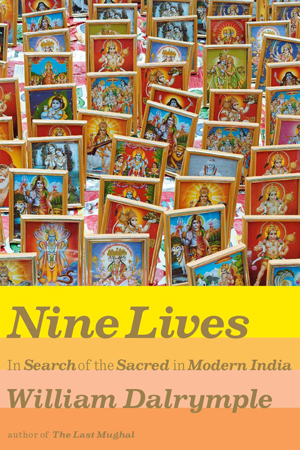
| Invitation |
| Author of NINE LIVES |
| Press Release |
| Reviews |
Nine Lives In Search of the Sacred in Modern India Presenting: William Dalrymple: Author BACKGROUND Nine Lives is a book about how South Asia's diverse sacred traditions are managing to cling on in the new India. THE BOOK & THE SHOW
On another trip, to Pakistan, travelling in the deserts of Sindh I came across the Shah Jo Raag Fakirs. These fakirs live together in a Sufi brotherhood and are custodians of one of the greatest and most unusual Sufi traditions in South Asia. Every day they sing the verses of the greatest poet in the Sindhi language, the eighteenth century Sufi master, Shah Abdul Latif of Bhit Shah who died in 1752. In Bengal I spent a month travelling with the Bauls. Throughout their five hundred year history, these wandering mistrells have refused to conform to the conventions of caste-conscious Bengali society. Subversive and seductive, wild and abandoned, they have preserved a series of esoteric spiritual teachings on breath, sex, asceticism, philosophy and mystical devotion. They have also amassed a treasury of beautifully melancholic and often enigmatic teaching songs which help map out their path to inner vision. Travelling from village to village, owning nothing but a multi-coloured patchwork robe, they sit in tea shops and under roadside banyan trees, in the compartments of trains and at village bus stops, busking their ballads about love and mysticism, divine madness and universal brotherhood to gatherings of ordinary Bengali farmers and villagers. The idea of bringing all these different traditions together, and putting them on stage with readings about the lives of the performers, came during last year's Jaipur Literature Festival, now the largest such event in Asia. Last year, one of the most remarkable events was an evening mixing Baul sacred music with Tamil thevaram hymns as sung by the celebrated London-born Tamil vocalist, Susheela Raman. The Thevaram songs which Susheela sings are taken from the seven volumes of devotional hymns written by the south Indian saints, first performed over a thousand years ago in Tanjore and the other great temples of Tamil Nadu. Until recently their words were the common property of all Tamils; now however the tradition is slowly beginning to die out. PERFORMANCE STRUCTURE Nine Lives opened at the Barbican, London at a sold out show for 3000 people in September 2009. It has since travelled to India, Ireland, Pakistan and Bangaldesh taking our message of mysticism and inter-religious tolerance. The show opens at the Sydney Opera House mid 2010 and thereafter to the UK and U Program Running Order:
|
 Nine Lives explores nine very personal stories-- a Sufi, a possession dancer, a Buddhist monk, a Jain nun, a Tantric and so on, each telling their own story, aiming to show how faith and ritual are clinging on in the face of India's commercial boom. Each life represents a different religious path, while revealing the perhaps surprising persistence of faith and ritual. My travels for the book have led me to meet some extraordinary individuals. In Kerala, I met Hari Das, a well builder and part-time prison warden for ten months of the year, who polices the violent running war between the convicts and gangsters of the two rival political parties, the far-right RSS and the hard-left Communist Party of India. But during the Theyyam dancing season, between January and March, Hari has a rather different job. Though he comes from an untouchable dalit background, he nevertheless is transformed into an omnipotent deity for two months a year, and as such is worshipped as a God. Then, at the end of March, he goes back to prison.
Nine Lives explores nine very personal stories-- a Sufi, a possession dancer, a Buddhist monk, a Jain nun, a Tantric and so on, each telling their own story, aiming to show how faith and ritual are clinging on in the face of India's commercial boom. Each life represents a different religious path, while revealing the perhaps surprising persistence of faith and ritual. My travels for the book have led me to meet some extraordinary individuals. In Kerala, I met Hari Das, a well builder and part-time prison warden for ten months of the year, who polices the violent running war between the convicts and gangsters of the two rival political parties, the far-right RSS and the hard-left Communist Party of India. But during the Theyyam dancing season, between January and March, Hari has a rather different job. Though he comes from an untouchable dalit background, he nevertheless is transformed into an omnipotent deity for two months a year, and as such is worshipped as a God. Then, at the end of March, he goes back to prison.